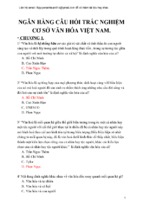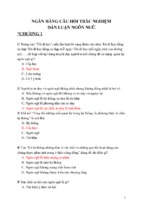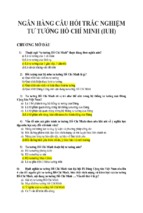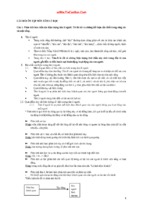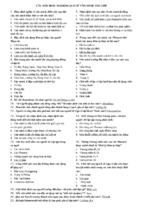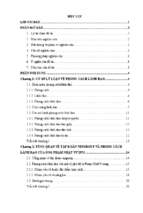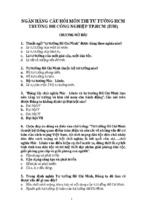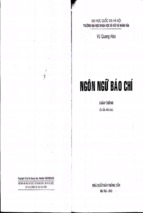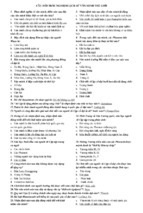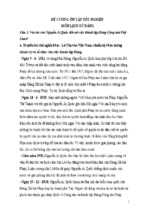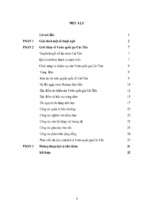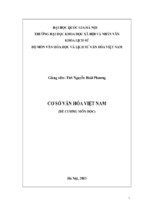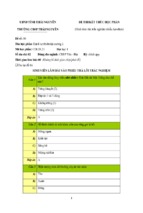MINISTRY OF EDUCATION AND TRAINING
FOREIGN TRADE UNIVERSITY
---------
SUMMARY OF DOTORAL THESIS
A STUDY OF FACTORS AFFECTING THE COLLABORATION IN
VIETNAM EXPORTED FRUITS AND VEGETABLES SUPPLY CHAIN
Field of study: International Economic
Code: 62.31.01.06 (new code: 9310106)
NGUYEN THI YEN
The thesis is completed at: Foreign Trade University
Supervisor: Assoc. Prof., Dr. Trinh Thi Thu Huong
Reviewer 1: ............................................................................
.........................................................................
Reviewer 2: .........................................................................
........................................................................
Reviewer 3: .........................................................................
.........................................................................
The thesis shall be defended in front of the Thesis committee at
University Level at Foreign Trade University
At.........hour.........date........month.........year 20
The thesis can be found at the National Library and
The Library of Foreign Trade University
LIST OF PUBLISHED WORKS OF THE AUTHOR
RELATING TO THE THESIS
1.
Nguyen Thi Yen (2019), “Factors effecting the collaboration in Vietnam
exported fruits and vegetables supply chain” External Economics Reviews, No
120/2019.
2. Nguyen Thi Yen (2018), “Fruits’s cold supply chain: experience of Japan
and lessons for Vietnam”, External Economics Reviews, No 104/2018.
3. Nguyen Thi Yen (2018), “Some recommendations to enhance collaboration
in Vietnam’s retail supply chain”, Academic Conferrence at University Level
“Vietnam retail market: perspectives for 2020 and beyond”, Foreign Trade
University, 08/2018..
INTRODUCTION
1. Rationale of the research:
Vietnam has advantages over agriculture and fruits and vegetables, of which the
export output has been increasing constantly through the years, are among the main
export products. However, the export output, although rising, still solely accounts for the
minority of domestic production, while export turn-over makes up a meager proportion of
worldwide demand at 1,5%. Clearly, it lacks food safety exported fruits and vegetables
supply chain, not the import markets.
The theory concerning collaboration in supply chain has been studied, applied in
reality for many years. Nonetheless, for developing countries as Vietnam, it is still a
brand new thing and has just been attached special importance to recently, which results
in the fact that a lot of companies do not understand deeply the extreme magnitude of
collaboration in export fruits and vegetables supply chain. Therefore, recognizing factors
affecting collaboration in supply chain, then finding out existing difficulties to provide
appropriate solutions are utterly imperative nowadays. For that reason, the writer chooses
“A study of factors affecting the collaboration in Vietnam exported fruits and vegetables
supply chain” to be the topic of the Ph.D. thesis.
2. Overview and related issues of thesis
2.1 General findings of supply chain collaboration
The thesis has reviewed and indicated the research results of a number of foreign and
domestic studies concerning the concept, the characteristics, the role of supply chain
collaboration, the level of collaboration and determinants of the collaboration in supply
chains.
2.2 General findings of fruits and vegetables supply chain collaboration
The thesis has reviewed and indicated the research results of a number of foreign and
domestic studies concerning the collaboration in fruits and vegetables supply chain and
its determinants.
2.3 Comments on previous reports and unsolved problems
General perception
In general, there have been a lot of researches on supply chain collaboration and its
determinant, which have been published in prestigious supply chain management
journals. These studies have clarified the concept of chain collaboration, the levels of
collaboration, the characteristics and the role of collaboration in improving and
developing the supply chain. From there, we can form the theoretical basis for research
on collaboration and its determinants. The number of domestic researches on
collaboration and its determinants is very limited.
Unsolved problems
Various studies have discussed the factors that influence collaboration within the
chain, however, the amount of researches is limited when it comes to a particular field.
Furthermore, studies have not yet identified all factors affecting the collaboration in the
export vegetable and fruit supply chain, but only at reasoning and surveying the
influencing factors. Domestic research on this issue is still limited, there is currently no
research on the analysis of factors affecting the collaboration in Vietnam exported fruits
and vegetable supply chain.
3. Research objectives and tasks:
The objectives of this thesis are to recognize and analyze factors affecting the
collaboration in Vietnam exported fruits and vegetables supply chain, then to find
solutions influencing such factors in order to reinforce the collaboration in Vietnam
exported fruits and vegetables supply chain. In addition, the thesis develops a scale
system for collaboration and factors affecting the collaboration in Vietnam exported
fruits and vegetables supply chain.
To achieve the aforementioned objectives, the thesis performs the following tasks:
Firstly, clarifying the rationale of supply chain, collaboration in supply
chain, recognizing and analyzing factors affecting the collaboration in export fruits and
vegetables supply chain. Secondly, creating and developing a system of scales for factors
affecting the collaboration in Vietnam exported fruits and vegetables supply chain.
Thirdly, analyzing the real situation of Vietnam exported fruits and vegetable supply
chain and collaboration in Vietnam exported fruits and vegetable supply chain.Fourth,
determining factors and their affecting level to collaboration in Vietnam exported fruits
and vegetable supply chain. Fifth, basing on the analyses of affecting level of factors to
provide solutions influencing factors in order to reinforce the collaboration in Vietnam
exported fruits and vegetable supply chain.
4. Research subjects and scope:
Research subjects are factors affecting the collaboration in Vietnam exported fruits
and vegetable supply chain. This thesis research on fruit and vegetable exporting
enterprises and co-operatives which are placed in the relationship with their suppliers,
distributors / customers. Exporting enterprises and co-operatives are the central enterprise
of the export fruit and vegetable supply chain, and their answers are generalized to assess
collaboration and the factors affecting collaboration in the supply chain.
Spatial research scope: the thesis researches on the collaboration in Vietnam
exported fruits and vegetable supply chain. In addition, the thesis researches on
experience lessons of India and Thailand.
Temporal research scope: statistics in the thesis are from 2010 to 2019 and were
collected from reports of state authorities such as General Department of Custom,
General Statistics Office,…
Research content scope: the thesis researches on the collaboration in export fruits and
vegetables supply chain. The thesis also focuses on researching into the vertical
collaboration in supply chain, specifically the collaboration between elements in the
Vietnam exported fruits and vegetable supply chain.
5. Research Methodology
This thesis approaches from the perspective of the state management agencies in
managing the activities of enterprise in Vietnam’s export fruits and vegetables supply
chain. Approaching the rationale concerning factors affecting the collaboration in
Vietnam exported fruits and vegetable supply chain. Approaching realistically through
surveys to evaluate the affecting level of factors to the collaboration in Vietnam exported
fruits and vegetable supply chain. Researching, evaluating on the reality of the
collaboration between elements in export fruits and vegetables supply chain in specific
domestic and international conditions and context; associating the development of the
supply chain and the collaboration in export fruits and vegetables supply chain with
national socio-economic development situation in the age of international economic
integration. The research combined of descriptive research and verification research.
6. Research significance:
6.1. Theoretical contribution:
Improving the theoretical framework about supply chain, collaboration in supply
chain and factors affecting the collaboration in supply chain. The new point of this thesis
is that the author has come up with a collaborative model in Vietnam exported fruits and
vegetables supply chain that is governed by 6 factors: two of which are commitment and
government support have certain impacts on the collaboration, 4 other factors of trust,
power, culture, business strategy that were published in previous research works. The
thesis developed and 5 scales of commitment factor, 4 scales of government support
factor and 5 scales of collaboration in Vietnam’s export fruits and vegetable supply chain.
This could be considered the first research on factors affecting the collaboration in
Vietnam exported fruits and vegetable supply chain, being the rationale for researches
towards different fields in Vietnam. The research uses both qualitative and quantitative
research methods to test the result, so it would add to the methodology of analysing the
collaboration in supply chain.
6.2. Realistic contribution:
Raising awareness of export fruits and vegetables businesses about the importance,
necessity of collaboration in supply chain. The thesis identifies the three factors with
greater influence are trust, power, and business strategy. The research also provides
solutions for businesses' consideration and for developing Vietnam exported fruits and
vegetable supply chain. The research is also a reliable reference material about supply
chain, collaboration in supply chain or methodology of metrology research and research
model test.
7.Structure:
Apart from introduction, table of contents, list of tables and figures, abbreviations,
references, conclusion, the thesis is divided into four chapters.
CHAPTER 1: SOME BASIC THEORETICAL ISSUES ON SUPPLY CHAIN AND
COLLABORATION IN SUPPLY CHAIN
1.1 Overview of supply chain
1.1.1 Concept of supply chain
There are many supply chain concepts, in general, they show that it is the link between
companies from the first stage of purchasing raw materials to producing and delivering
products to customers. According to the author, the concept introduced by Chopra, Sunil
and Peter Meindl is more complete when it comes to the role of the links in the supply
chain. Accordingly, the supply chain is composed of all activities participated directly
and indirectly in supplying products to end customers. In addition to businesses directly
involved in meeting customer needs such as suppliers, manufacturers, distributors,
indirect stakeholders such as transportation, information, warehousing service providers
also play an important role. This is a sufficient condition for businesses to serve
customers with optimal service and cost.
1.1.2 Objectives of supply chain management
The supply chain is composed of all activities involved in the supply of products to the
end customers, so the ultimate goal of supply chain management is to satisfy customer
needs and enhance overall value of the chain.
1.1.3 The basic elements of the supply chain
The thesis indicates five basic elements of the supply chain: production, inventory, place,
delivery and information. Manufacturing in the supply chain refers to the capacity of the
chain to create and store products. Inventories are in the supply chain and range from raw
materials to finished products, semi-finished products, held by manufacturers, distributors
or retailers in the chain. Place is understood as the choice of the geographical location of
supply chain facilities and the identification of activities that need to be taken by each
vehicle. Delivery involves moving from raw materials to finished products under
different conditions in the supply chain. Finally, information is the key element related to
the four remaining basic ones of the supply chain. Information is to connect all activities
in the chain, when the information is transmitted accurately, fully and promptly, the
parties in the supply chain will be able to make an accurate decision for their own
activities.
1.1.4 Basic components of the supply chain structure
A supply chain consists of components interrelated and interacted with each other are
suppliers, manufacturers, consumers and intermediary organizations. In each supply
chain, products are moved from the supplier to the manufacturer, distributor, customer
(retailer) and end customers along the supply chain. In fact, manufacturers may receive
raw materials from many other suppliers and then supply them to distributors, which
forms supply networks.
1.2 Collaboration in the supply chain
1.2.1 Definition
The thesis points out some concepts of supply chain collaboration, whereby we can
understand that a collaborative supply chain in which members jointly plan and carry out
supply chain activities in order to bring the best benefits to each member and the whole
supply chain as well as aiming to best satisfy customers' needs.
Collaboration can bring the benefits to the supply chain as following: Increase accuracy
for forecasting demand, shorten order processing time; Improve productivity and product
quality, boost businesses' competitive position of in the industry.
1.2.2 Classification
According to Togar and Sridharan (2007), supply chain collaboration can be divided into
three categories: Vertical Collaboration, Horizontal Collaboration and Lateral
Collaboration.
- Vertical Collaboration: vertical collaboration occurs when two or more organizations,
such as manufacturers, distributors, carriers, and retailers share responsibility, resources
and information to intend to serve related organizations similar to the end consumer.
- Horizontal Collaboration: horizontal collaboration is the cooperation between factors in
the same stage to reduce costs and increase product prices.
- Lateral Collaboration: lateral collaboration has the characteristics of both types of above
collaboration, the flexibility due to the combination of benefits from coordinating
components throughout the chain of vertical collaboration and from sharing resources of
horizontal collaboration.
Besides, considering supply chain collaboration should be associated with supply
chain organization structures, including: basic struture, collaboration, partnership, tiers,
integration.
1.2.3. The criteria to evaluate the collaborative between supply chains
The thesis states and explains the criteria of assessment to the collaboration between
supply chains. Simatupang và Sridharam (2008) listed out five criteria, including:
decision synchronization, system of collaborating execution, binding stimulation, creative
supply chain, and information sharing. The content of collaboration is listed in the table
below:
Content
Sources
COL1 The components in supply chains and the Simatupang and Sridharam (2008)
chain activities plans.
COL2 The components in the supply chains Simatupang and Sridharam (2008)
always
evaluate
the
collaboration
procedure
COL3 The components in the supply chains Simatupang and Sridharam (2008), Fisher
always collaborate to develop new (1997); Simchi-Levi and partners, 2003
products and the market.
COL4 The components in the supply chains Simatupang and Sridharam (2008), Fisher
always collaborate to execute chains (1997); Simchi-Levi and partners, (2003)
activities.
COL5 The components in the supply chains Simatupang and Sridharam (2008),
always share information.
Subramani (2004); Zhang and Chen (2013)
1.3 Factors affecting the collaboration in the vegetable supply chains for exportation
and original research model
1.3.1 The characteristics of collaboration in Vietnam exported fruits and vegetable
supply chains
Collaboration in the export fruits and vegetables supply chain has the following
characteristics: first is the end-customer in foreign markets and the consumption of
products will be acted by the foreig importing enterprises. Secondly, the production and
manufacturing process in the chain must based on the rigorous standards of various
importing contries in the world. All parners need to keep up to date with these standards.
Thirdly, in the export supply chain, the transportation and consumption time will be
longer than domestic consumption, the type, quantity and quality are also different. The
fourth is that the fruits and vegetables are seasonal and acquisition depends heavily on
foreign partners. Fifthly, vegetables and fruits are greatly influenced by natural conditión
such as condition of land, climate, topography, water resources, etc and import-export
policy of the exporting and importion countries.
1.3.2 Factors affecting the collaboration in Vietnam exported fruits and vegetable
supply chains
1.3.2.1 Trust between counterparts
In this research, trust is defined as the range of which enterprises trust their
counterparts in the supply chain to fulfil their responsibility based on goodwill.
Researches have pointed out the elements in the scale of trust (TRU) including: Our
counterpart (the supplier and the importer) are always open-minded and never conceal
their business objectives (TRU1), our counterparts always have positive altitude in
mutual agreements (TRU2), we believe that our counterparts is honest (TRU3),
components in the chains always respect each other (TRU4), counterparts always care
about our problem (TRU5). When exporters believe in food hygiene, safety and quality
of growers and are aware of its importance to health and purchase decisions of
consumers, they will certainly cooperate with farmers to build that trust, so:
H1: There is a positive relationship between trust and collaboration in Vietnam
exported fruits and vegetable supply chain.
1.3.2.2 Power
When designing a cooperative supply chain with other enterprises, the business,
itself, has to consider the scale, effect and status of other enterprises. Researches about
power pointed out the elements in the power scale including: The components in the
chain share equal power when making decision about the activities of the chain
(producing, distributing, selling, researching and developing…) (POW1), both the
supplier and the importer have influence to our decision (of producing, distributing,
selling, researching and developing…) (POW2), we have influences to partners’ decision
(producing, distributing, selling, researching and developing…) (POW3). The power
between the parties will influence the decisions on activities in export fruits and
vegetables supply chain, namely the greater the influence between the parties is, the more
regularly they will have to contact to work and exchange together. This leads to the
following hypothesis:
H2: There is a positive relationship between power and collaboration in Vietnam
exported fruits and vegetable supply chain
1.3.2.3 Commitment
Cooperating commitment is defined as the range of which partners in the supply
chains will maintain and stimulate their business relationships. Researches about
cooperating commitment showed out the scale including: the components are expected to
maintain the business relationship (CMM1), the components are willing to enrich and
extent the relationship with their partners (CMM2), we spend lots of time to build up the
relationship with other partners (CMM3), we invest a subsequent amount of budget into
building up relationship with other partners (CMM4), the relationship with partners is
more important than short-term interest (CMM5). Commitments play a very important
role in developing collaboration in the supply chain. Therefore:
H3: There is a positive relationship between commitment and the collaboration in
Vietnam exported fruits and vegetable supply chain.
1.3.2.4 Culture
Culture commonesses is defined as the range of which partners in the supply chain
have value, belief and managing methods that is in common with each other. Researches
about culture commonesses describe the element in this scale including: we have culture
in common (about languages, desires, habits…) (CUL1), we could easily understand the
term and business method of our partners (CUL2), we always agree with solutions to
handle difficulties and hardship of our partners (CUL3). Cultural similarity also
facilitates inter-organizational cooperation (Melvor and Humphreys 2002). Therefore:
H4: There is a positive relationship between cultural similarity and collaboration in
Vietnam exported fruits and vegetable supply chain.
1.3.2.5 Business strategy
Business strategy compatibility is defined as the extent to which supply chain
partners have clear and agreed business strategy goals. Studies of business strategies have
also shown that the components of the scale include: The components of the chain jointly
develop common business goals for the export fruits supply chain (BS1), the components
of the chain is highly in agreement about the common business goals of the export fruits
supply chain (BS2), all members of the chain understand the partners's business goals
(BS3), all partners understand their rights and obligations in the operation of the export
fruits supply chain (BS4). Sharing common business strategies will serve as a guideline
for cooperation activities between partners and facilitate integration and use of resources
(Wathne and Heide 2000). Therefore:
H5: There is a positive relationship between the compatibility of business strategy and
collaboration in Vietnam exported fruits and vegetable supply chain.
1.3.2.6 Government support
In the complicated and extensive operations of the supply chain, there is a need to
enhance cooperation between businesses and governments, national and international, to
control and manage risks effectively in global supply chains. Studies of government
support have also shown that the components of this scale include: The Government of
Vietnam has implemented policies and special projects to support our company (GS1),
the Vietnamese government gives the necessary information on time (GS2), the
Vietnamese government provides financial support to our company (GS3), the
government supports other resources for our company (GS4). According to Mentzer,
2001, it is difficult to cooperate with any actors who want to participate in the supply
chain in the industry but do not meet the national and international policies and laws.
Therefore:
H6: There exists a positive relationship between government support and collaboration in
Vietnam exported fruits and vegetable supply chain.
1.3.2 The original research model
From the above-mentioned assumptions, the research model consists of six factors
(six independent variables) that all positively affect the collaboration (dependent
variable) in Vietnam exported fruits and vegetable supply chain.
1.4 Experience in developing cooperation in the export fruits and vegetables supply
chains of India and Thailand
1.4.1 Experience of India
The dissertation introduces the general export of Indian vegetables and fruits and the
cooperation in the Indian export vegetables and fruits supply chain. From there, draw
lessons for Vietnam. Firstly, for the farmers, they have formed the link through the group
of vegetable farmers thanks to the intermediaries of distribution and government support
policies. Second, the signing of production contracts. Thirdly, intermediary retail
organizations have promoted their role very well. Fourth, the Indian government has well
performed its role of supporting and promoting production as well as domestic
consumption of fruits and vegetables.
1.4.2 Experience of Thailand
The dissertation provides a general introduction about Thai fruits and vegetables export
and the cooperation in Thai fruits and vegetables export supply chain. From there, draw
lessons for Vietnam. Firstly, sharing goodwill information among the components of the
export vegetables and fruits supply chain. Second, promoting the supporting role of
associations. Third, exporters focus on developing a collaborative relationship between
the components of the exports vegetable and fruits supply chain.
CHAPTER 2: RESEARCH PROCESS AND METHODOLOGY
2.1 Research process
2.1.1 An overview of the research process flowchart
The research process of the thesis consists of 6 steps, namely: identifying research
objectives, collectiong and reviewing documents, collecting research data, preliminary
research, formal research, research result’s report.
2.1.2. The steps in the research process
This study clearly explains the activities and purposes of each step in the research process
of the research.
2.2 Secondary research data
Secondary data was collected through field research by reviewing data from published
data sources. Its included reports from The General Statistics Offices, Vietnam Frui and
Vegetable Association, Information Center of the Strategic Policy Institute for Rural
Development and Vietnam Chamber of Commerce and Industry (VCCI)
The secondary data is analyzed base on the qualitative analysis methods, including
general and matching methods, logical reasoning methods and statistical and modeling
methods
2.3 Primary research data
2.3.1 Qualitative analysis methods
Group discussion
The purpose of this method is to guide factors that influence collaboration in
Vietnam’s export fruits and vegetables supply chain, developing scales for these factors
to conduct expert interview.
Expert interview
The expert interview aims to evaluate the contents of the influencing factors and the
scales for official quantitative research, as well as preliminary assessment of the level of
collaboration in Vietnam’s export fruits and vegetables supply chain.
2.3.2 Quantitative analysis methods
The thesis used questionnaire survey in order to point the model of theoretical
research, and make assessments and propose solutions.
This research uses random sampling and propose-sampling techniques to be
conducted for exporters and cooperatives in Vietnam exported fruits and vegetables
supply chain. The formal questionnaire has 29 items including 24 items for the scale of
factors affecting supply chain collaboration, and 5 items for the dependent variable. Each
question item was graded on a Likert scale from 1 to 5 with the convention of strongly
disagree (1) to strongly agree (5). The content of the scales was combined by the author
from the published research, then translated into Vietnamese and discussed with the
group of enterprises who participating in in-depth interviews to adjust some concepts
accordingly. The thesis built a questionnaire to survey enterprises producing and
exporting fruits and vegetables, cooperatives and conducted surveys at 138 enterprises
and cooperatives in regions of Vietnam.
The data will be cleaned, coded for quantitative analysis using SPSS 20.0
Testing the scale of Cronbach’s Alpha: This test allows assessing the reliability of
establishing a composite variable on the basis of many single variables
Exploration factor analysis method (EFA): This method used to test the convergence of
conceptual component variables. Exploratory factor analysis is useful in indentifying
necessary variables for research issues as well as for finding relationship between
variables.
Pearson correlation test method: This method is used to check the linear correlation
between dependent variable and independent variable.
Multivariate linear regress analysis: This method helps clarify the relationship between
independent variables and dependent variable in the research model.
CHAPTER 3: ANALYSIS THE FACT OF FACTORS AFFECTING
THE COLLABORATION IN THE VIETNAM EXPORTED FRUITS AND
VEGETABLE SUPPLY CHAIN
3.1 The Overview of the Vietnam vegetable and fruit production and export.
3.1.1 The fact of the Vietnam vegetable and fruit production.
Vietnam has the advantage of climate and soil conditions with over 70% of the
population working in agriculture and above 1.5 million hectares of area for vegetable
cultivation. However, Vietnam's vegetable and fruit exports in 2018 reached about 3.52
billion USD, accounting for a very small share of the total global vegetable and fruit trade
of nearly 1,000 billion USD, not to mention the domestic market of more than 90 million
people with the growing demand. Moreover, the trend of high technology investment in
the agricultural industry grows more and more strongly. Until September 2019, the
vegetable cultivation area nationwide reached nearly 980 thousand hectares and increased
1.8% with yielding about 172.2 quintals / ha. The Vietnamese vegetable structure is
diverse and plentiful with the current large-yield vegetables such as choy sum, cabbage,
cucumbers, corn, water spinach and some spice vegetables such as onions, garlic, etc.
Regarding fruits, the area of fruit cultivation of the whole country in 2018 reached 923.2
thousand hectares, an increase of 4.4% compared to 2017, mainly increased in fruit trees
such as oranges, grapefruit, dragon fruits, papaya ...
3.1.2 The fact of the Vietnam fruits and vegetables
3.1.2.1 Vietnam's export turnover of fruits and vegetables
Vietnam's export turnover of fruits and vegetables continuously increased by about
30% compared to the previous year as of 2017, and then increased by about 10% in 2018.
Especially export turnover of fruits and vegetables in 2017 increased by more than 40%
compared to the previous year in 2016. It was the first year that vegetable and vegetable
export turnover surpassed crude oil and rice and was among the Top 5 items with export
turnover of over 3 billion US dollars. In 2019, however, the export turnover of vegetables
and fruits decreased in three consecutive months (from May to July) with the decrease of
23.1%, 21.8% and 11% in turn (Nhat Ha, 2019). It was considered as the temporary
situation because China ended the Vietnam's quota export and changed into the official
one from June 1, 2019.
3.1.2.2 Structure of Vietnam's fruits and vegetables
In particular, fruits are the main export products, accounting for the highest
proportion in the structure of Vietnam's exported fruit and vegetables, and followed by
the other products including flowers, processed products, fresh vegetables and leaves.
3.1.2.3 Structure of Vietnam’s export market of fruits and vegetables
Regarding the export markets, Vietnam's vegetables and fruits have been exported to
more than 60 countries and territories until March, 2019. The main export markets for
fruits and vegetables of Vietnam are China, followed by the US, South Korea and Japan,
which are also the main export markets of Vietnam.
3.2 The components of the Vietnam exported fruits and vegetable supply chain.
The thesis has pointed out the structure and the fact of each component in Vietnam
exported fruits and vegetable supply chain. It has started to invest on farmers or made the
contract with farmers in charge of carrying out the segments of production including seed
selection, fertilizer, harvesting and preliminary processing. After that, traders usually buy
from farmers in the same area and move to processing enterprises or small traders in the
purchasing centers or wholesale markets or export and trade enterprises. From here
vegetables and fruits will be exported to partners, which are foreign import enterprises,
and delivered to the last consumers.
3.3. The collaboration of the Vietnam exported fruits and vegetable supply chain.
According to the survey of 138 enterprises, the co-operative plays a central role as
collaboration in the Vietnam exported fruits and vegetable supply chain. Many
enterprises, which filled in the survey, said that they just started to know about the
concept of “collaboration in supply chain” or even never heard about this before. and
nearly 55% of them said that they have heard about this before. Because of the limited
knowledge about the collaboration, enterprises , as well as input and output partners have
many difficulty in the degree of collaboration in the current supply chain.
3.3.1 The fact of the collaboration in the Vietnam exported fruits and vegetable supply
chain.
When considering the collaboration in the Vietnam exported fruits and vegetable
supply chain, the author assessed based on the criteria mentioned in Section 2.2.3,
including:
The synchronization decision
According to the overall assessment (the average value of the COL1 scale), this
criterion is the highest, it means that the partners collaborate primarily through joint
planning in supply chain operations. Collaboration is shown at the first step of chain
operations and also demonstrates the will of the parties wishing to collaborate. The
linkage between the parties is still weak and unsustainable. In addition, 90% of Vietnam
vegetables and fruits are exported in raw and semi-processed form, leading to less
collaboration in processing activities and planning of supply chain activities.
The collaborative execution system
This indicator reflects a lower average value (COL2). The system of collaborative
implementation in Vietnam exported fruits and vegetable supply chain is demonstrated
through the evaluation of contracts between farmers and processing enterprises.
Regarding to the chain, these contracts are mainly fulfilled through an intermediary stage,
called traders. According to the Southern Fruit Institute, 2.5% of fruits and vegetables is
directly signed between businesses and growers, while the remaining 97.5% of them are
consumed under contracts signed with traders and intermediaries. Thus, farming
contracts, showing the collaboration between the parties in the chain, have appeared and
implemented in a small number of enterprises but have not achieved the best effect.
The incentive linkage
This is shown in working together to develop market and new product (COL3), on the
other hand, the value of this observation is not high (3.22). Although members of the
chain expressed their desire to collaborate, the incentive linkage was not from members
in the relationship between growers and exporters of fruits and vegetables. It was mainly
promoted through measures and policies of government.
The procedure of a creative supply chain
A creative supply chain owns a procedure that ensures the unification and the
flexibility in all activities of the network.Vietnam exported fruits and vegetable supply
chain will be closely analyzed in terms of produce traceability to assess this issue. One
the one hand, the consumers’ requirement for the quality of the goods becomes higher
and higher. One the other hand, the inputs used by the farmers who take responsibility for
planting products are not under control of the exporting companies. The produce
traceability of Vietnam exported fruits and vegetable supply chain seems to be not
standardized enough because all relating information is simply recorded by the farmers’
handwritten books. The enterprises collect them from the farmers as their method for
produce traceability.
Information sharing
The observation value - COL5 ( the elements in supply chain share information
frequently) was at the point of 3.22. This number was over the mean point but still in a
low point. Though these elements have connected to inform the others, they haven’t
supported each other to find solutions while problems come up. Instead, they have tried
to define who would be at fault, and then let themselves manage as responsibility.
3.3.2 The assessment of the fact about the collaboration in Vietnam exported fruits and
vegetable supply chain
Achievements
There exists factors building the collaboration of Vietnam exported fruits and
vegetable supply chain. In addition, Vietnamese government continued to have certain
actions to make the relationships among the farmers, the representatives of the farmers,
and the exporters tighter by doing trade promotions in Vietnam and a lot of campaigns to
promoting Vietnam fruits and vegetables in other countries.
Limitations
The farmer haven’t given information directly to the exporter. The flow of these
information often goes through the dealers.The farming contracts has been put into
practices, but it doesn’t work to make the links among the parties tighter as much as
expected. There still exists unsynchronized decisions and lacks encouragement to more
interactions between the farmer and the exporter. In conclusion, Traceability , the key
issue of the creative supply chain, still implies many difficulties such as: the infrequentlyupdated data, the limitation of applying advanced technology. The research and
development in it have not been practical enough to come into true.
3.3.3 The benefits and difficulties in pushing the collaboration of Vietnam exported
fruits and vegetable supply chain
Benefits
The freedom trade agreements that Vietnam signed have taken effect, so that the
elements in the supply chain have more chances of meeting the others, specially for
Vietnam exporting fruits and vegetables enterprises and their own foreign business
partners. Besides, these freedom trade agreements contain clauses helping to improve the
productivity of supply chain with an unification and convenient working style. That
contributes much to the increase in collaboration of Vietnam exported fruits and
vegetable supply chain.
The fruits and vegetables’ consumption has continually grown up. It causes the
increase in exporting activity. Therefore, the efficiency of the supply chain requires every
element in it to collaborate together for the most utilization. As a result, every member in
the supply chain will get a higher profit.
Difficulties
The quality and the safety of products have still not been in high. It prevents
Vietnamese exporting companies having more chance of doing business with foreign
ones. As a result, the collaboration in the supply chain becomes weaker.
Keeping supply sources stable and holding enterprises’ prestige. The international
partners have concerned about the sustainability of Vietnamese supply sources and the
ability to complete obligations. In both long-term and short-term, Vietnam should take
more actions to build a stronger belief or trust or they may loose many potential chances.
Raising a higher awareness about market development, improving ability
competency. Pricing is one of the warning issues that Vietnamese exporting fruits and
vegetables companies have to face. Because of the limitation of the scale of the farms and
the production capacity, Vietnamese companies find it hard to compete with same
products, especially vegetables and fruits from China. Therefore, in long running,
Vietnamese enterprises should focus long-term goals when conducting research to
develop stronger with priority to enhancing the cooperation with the elements of
Vietnam's export vegetable and fruit supply chain.
3.4. Quantitative analysis of factors affecting the collaboration in Vietnam exported
fruits and vegetable supply chain
3.4.1 Results of evaluating Cronbach’s Alpha scale and analysing exploratory factor
EFA
The author runs Cronbach’s Alpha in turn for each factor. After the first run, the
observed variable TRU5 is rejected because the correlation coefficient of the total is
0.212 which is less than 0.3 and if this observation is excluded, the result of Cronbach’s
Alpha will increase. After eliminating the TRU5 observation from the research model, all
7 scales have the Cronbach’s Alpha coefficient satisfactory because they are all greater
than 0.6, the correlation coefficients of the total are all higher than 0.3. Particularly for
the observed variable GS2, if this variable is rejected, the Cronbach's Alpha coefficient
will increase, but because the correlation of the total is 0.529 which is still greater than
0.3 and and as keeping this observation, the Cronbach’s Alpha coefficient on the scale of
government support remains high (0.825) so the author decided to keep it for EFA factor
analysis. Thus, Cronbach’s Alpha analysis only removes TRU5 observation, all the
remaining observations for the 7 scales are retained for EFA analysis.
- Xem thêm -

